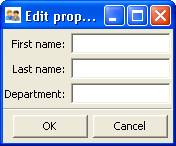Customizing a View¶
As shown in the preceding two chapters, it is possible to specify a window in TraitsUI simply by creating a View object with the appropriate contents. In designing real-life applications, however, you usually need to be able to control the appearance and behavior of the windows themselves, not merely their content. This chapter covers a variety of options for tailoring the appearance of a window that is created using a View, including the type of window that a View appears in, the command buttons that appear in the window, and the physical properties of the window.
Specifying Window Type: the kind Attribute¶
Many types of windows can be used to display the same data content. A form can appear in a window, a wizard, or an embedded panel; windows can be modal (i.e., stop all other program processing until the box is dismissed) or not, and can interact with live data or with a buffered copy. In TraitsUI, a single View can be used to implement any of these options simply by modifying its kind attribute. There are seven possible values of kind:
- ‘modal’
- ‘live’
- ‘livemodal’
- ‘nonmodal’
- ‘wizard’
- ‘panel’
- ‘subpanel’
These alternatives are described below. If the kind attribute of a View object is not specified, the default value is ‘modal’.
Stand-alone Windows¶
The behavior of a stand-alone TraitsUI window can vary over two significant degrees of freedom. First, it can be modal, meaning that when the window appears, all other GUI interaction is suspended until the window is closed; if it is not modal, then both the window and the rest of the GUI remain active and responsive. Second, it can be live, meaning that any changes that the user makes to data in the window is applied directly and immediately to the underlying model object or objects; otherwise the changes are made to a copy of the model data, and are only copied to the model when the user commits them (usually by clicking an OK or Apply button; see Command Buttons: the buttons Attribute). The four possible combinations of these behaviors correspond to four of the possible values of the ‘kind ‘ attribute of the View object, as shown in the following table.
Matrix of TraitsUI windows
| not modal | modal | |
|---|---|---|
| not live | nonmodal | modal |
| live | live | livemodal |
All of these window types are identical in appearance. Also, all types support the buttons attribute, which is described in Command Buttons: the buttons Attribute. Usually, a window with command buttons is called a dialog box.
Wizards¶
Unlike a window, whose contents generally appear as a single page or a tabbed display, a wizard is presented as a series of pages that a user must navigate sequentially.
TraitsUI Wizards are always modal and live. They always display a standard wizard button set; i.e., they ignore the buttons View attribute. In short, wizards are considerably less flexible than windows, and are primarily suitable for highly controlled user interactions such as software installation.
Panels and Subpanels¶
Both dialog boxes and wizards are secondary windows that appear separately from the main program display, if any. Often, however, you might need to create a window element that is embedded in a larger display. For such cases, the kind of the corresponding View object should be ‘panel’ or ‘subpanel ‘.
A panel is very similar to a window, except that it is embedded in a larger window, which need not be a TraitsUI window. Like windows, panels support the buttons View attribute, as well as any menus and toolbars that are specified for the View (see Menus and Menu Bars). Panels are always live and nonmodal.
A subpanel is almost identical to a panel. The only difference is that subpanels do not display command buttons even if the View specifies them.
Command Buttons: the buttons Attribute¶
A common feature of many windows is a row of command buttons along the bottom of the frame. These buttons have a fixed position outside any scrolled panels in the window, and are thus always visible while the window is displayed. They are usually used for window-level commands such as committing or cancelling the changes made to the form data, or displaying a help window.
In TraitsUI, these command buttons are specified by means of the View object’s buttons attribute, whose value is a list of buttons to display. [6] Consider the following variation on Example 3:
Example 4: Using a View object with buttons
# configure_traits_view_buttons.py -- Sample code to demonstrate
# configure_traits()
from traits.api import HasTraits, Str, Int
from traitsui.api import View, Item
from traitsui.menu import OKButton, CancelButton
class SimpleEmployee(HasTraits):
first_name = Str
last_name = Str
department = Str
employee_number = Str
salary = Int
view1 = View(Item(name = 'first_name'),
Item(name = 'last_name'),
Item(name = 'department'),
buttons = [OKButton, CancelButton])
sam = SimpleEmployee()
sam.configure_traits(view=view1)
The resulting window has the same content as before, but now two buttons are displayed at the bottom: OK and Cancel:

Figure 4: User interface for Example 4
There are six standard buttons defined by TraitsUI. Each of the standard buttons has matching a string alias. You can either import and use the button names, or simply use their aliases:
Command button aliases
| Button Name | Button Alias |
|---|---|
| UndoButton | ‘Undo’ |
| ApplyButton | ‘Apply’ |
| RevertButton | ‘Revert’ |
| OKButton | ‘OK’ (case sensitive!) |
| CancelButton | ‘Cancel’ |
Alternatively, there are several pre-defined button lists that can be imported from traitsui.menu and assigned to the buttons attribute:
- OKCancelButtons = [OKButton, CancelButton ]
- ModalButtons = [ ApplyButton, RevertButton, OKButton, CancelButton, HelpButton ]
- LiveButtons = [ UndoButton, RevertButton, OKButton, CancelButton, HelpButton ]
Thus, one could rewrite the lines in Example 4 as follows, and the effect would be exactly the same:
from traitsui.menu import OKCancelButtons
buttons = OKCancelButtons
The special constant NoButtons can be used to create a window or panel without command buttons. While this is the default behavior, NoButtons can be useful for overriding an explicit value for buttons. You can also specify buttons = [] to achieve the same effect. Setting the buttons attribute to an empty list has the same effect as not defining it at all.
It is also possible to define custom buttons and add them to the buttons list; see Custom Command Buttons for details.
Other View Attributes¶
Attributes of View, by category
| Category | Attributes | Description |
|---|---|---|
| Window display |
|
These attributes control the visual properties of the window itself, regardless of its content. |
| Command |
|
TraitsUI menus and toolbars are generally implemented in conjunction with custom Handlers; see Menus and Menu Bars for details. The key_bindings attribute references the set of global key bindings for the view. |
| Content |
|
The content attribute is the top-level Group object for the view. The object attribute is the object being edited. The imports and drop_class attributes control what objects can be dragged and dropped on the view. |
| User help |
|
The help attribute is a deprecated way to specify that the View has a Help button. Use the buttons attribute instead (see Command Buttons: the buttons Attribute for details). The help_id attribute is not used by Traits, but can be used by a custom help handler. |
| Unique identifier |
|
The id attribute is used as a key to save user preferences about a view, such as customized size and position, so that they are restored the next time the view is opened. The value of id must be unique across all Traits-based applications on a system. If no value is specified, no user preferences are saved for the view. |
Footnotes
| [6] | Actually, the value of the buttons attribute is really a list of Action objects, from which GUI buttons are generated by TraitsUI. The Action class is described in Actions. |
